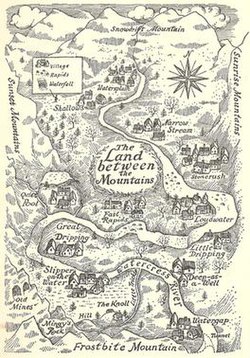The Gammage Cup
[2]The Gammage Cup was illustrated by Erik Blegvad and was first published in 1959 by Harcourt Brace in New York.
This valley is populated by twelve villages of Minnipins, a race of industrious "little people" rather like hobbits.
[4] The novel takes place in a village called Slipper-on-the-Water, in and around the gold mines in the Sunset Mountains and on a nearby knoll where the outlaws live.
The date of the story is given as the year of Gammage Slipper-on-the-Water is home to a clan known as the Periods, who are descendants of Fooley the Magnificent or the Great Fooley, who 440 years before the book opens constructed a balloon, flew to the land beyond the mountains and returned with a case of curiosities.
One night, a Minnipin named Muggles wakes up and sees fires in the Sunset Mountains in the West.
While digging for treasure, Walter the Earl discovers a vault under his house and finds iron chests that contain ancient scrolls, swords, armor and military trumpets.
Muggles organizes their working efforts and after much progress is made, they explore the Old Mines in the Sunset Mountains.
After this phenomenon occurs again, they assume that the legendary enemies of the Minnipins known as The Mushrooms have returned and are preparing to attack, and they hold a council of war.
In the mines, Mingy sees several hairless creatures with mushroom-colored skin round bellies and big ears and wearing tight, brownish-white clothes.
Curly Green and Muggles stay and defend Gummy while Walter the Earl returns to Slipper-on-the-Water to raise an army to fight the Mushrooms.
Walter the Earl tries to tell the Periods mayor and council about the coming Mushroom army but they will not listen.
Gummy becomes weak because of the poison from the spear and Curly Green is knocked out while Muggles wards off the Mushrooms.
Mingy emerges from the cave holding the pot of white substance which is used cure Gummy and the injured Minnipins soldiers.
The Period village council regrets expelling the Outlaws and no longer cares about winning the Gammage Cup.
Witnessing the happy scene, they decide that Slipper-on-the-Water is the most deserving village and leave the Gammage Cup in the town square.
[6] Muggles' heroism makes the book appear feminist; Kendall neither confirmed or denied this, saying "I just write the way it is".
The New York Times Book Review called it "highly amusing, imaginative, and thought provoking".
[5] In 2001, a review in Black Gate described The Gammage Cup as readable and enjoyable with a cute turn of phrase and clever notions, though standing "at best in the second rank of the great children's fantasies."
[10] Interest in the book was revived during the 1999 lawsuit between Nancy Stouffer and J.K. Rowling over the creation of the name "Muggles".
[7] An article in the Lawrence Journal-World on June 14, 2000, said Kendall had used the name about 30 years before Stouffer and Rowling.
It was read by Christina Moore who was praised by School Library Journal, which said it conveys "the full emotional range of each character".
The reviewer also said, "Moore consistently nails the perfect tone of the story" and, "this delightful fantasy is sure to please fans on several levels—humor, suspense, plot twists, winsome characters, and adventure".
